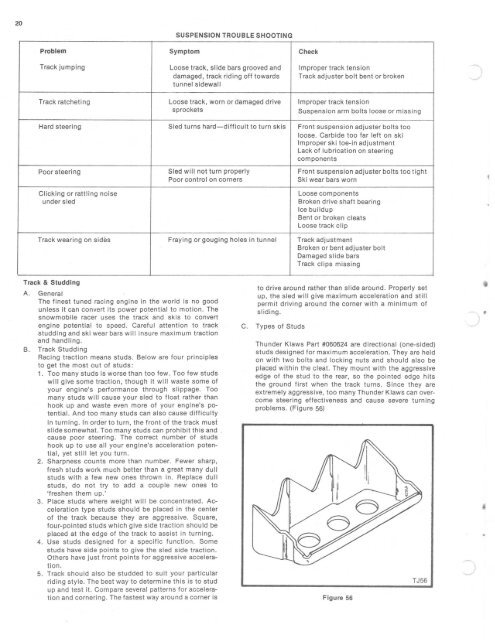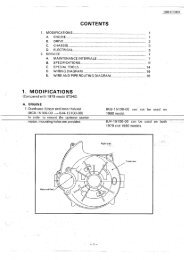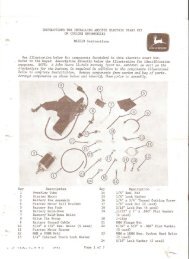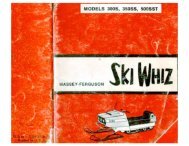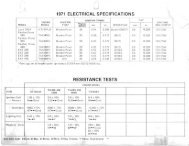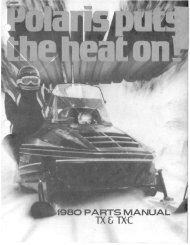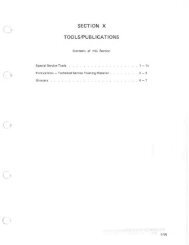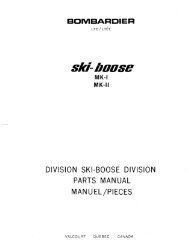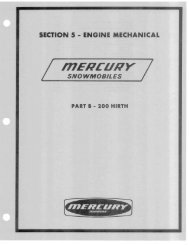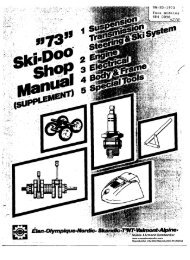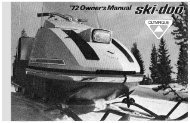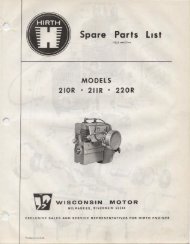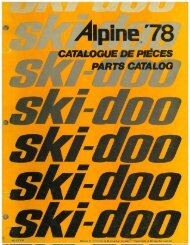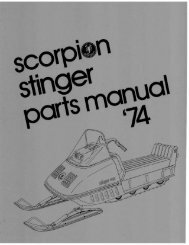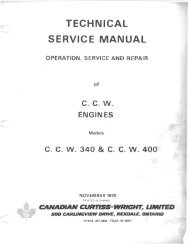1975 Thunderjet - Vintage Snow
1975 Thunderjet - Vintage Snow
1975 Thunderjet - Vintage Snow
Create successful ePaper yourself
Turn your PDF publications into a flip-book with our unique Google optimized e-Paper software.
20<br />
SUSPEN SION TROUBLE SHOOTING<br />
Problem Symptom Check<br />
Track j umping Loose track, slide bars grooved and Improper track tension<br />
damaged, track riding off towards Track adjuster bolt bent or broken<br />
tunnel sidewa ll<br />
Track ratcheting Loose tr ack, worn or damaged drive Improper track ten sion<br />
sprockets<br />
Suspension arm bo lt s loose or missing<br />
Hard steering Sled turns hard-difficult to turn ski s Front suspension adjuster bolts too<br />
loose. Carbide too far left on ski<br />
Improper ski to e-in adjustment<br />
Lack of lubricat ion on steering<br />
components<br />
Poor steering Sled will not turn properly Front suspension adjuster bolts too tight<br />
Poor control on co rners<br />
Ski wear bars worn<br />
Cl icking or rattling noise<br />
und er sled<br />
Loose components<br />
Broken drive shaft bearing<br />
Ice buildup<br />
Bent or broken cleats<br />
Loose tr ack cl ip<br />
Track wearing on sides Fraying or gouging holes in tunnel Track adjustment<br />
Broken or bent adjust er bolt<br />
Damaged slide bars<br />
Track clips missing<br />
Track & Studding<br />
A. General<br />
The f ine st tuned racing engine in t he world is no good<br />
unless it can convert its power potential to motion. The<br />
snowmobile racer uses the track and skis to convert<br />
engine potential to speed . Careful attention to track<br />
studding and ski wea r bars w ill insure maximum tr action<br />
and handling.<br />
B. Track Studding<br />
Racing traction means studs. Below are four principles<br />
to get the mo st out of studs :<br />
1. Too many studs is worse than too few. Too few studs<br />
will give some traction, though it wi ll waste some of<br />
your engine's performance through slippage. Too<br />
many studs w ill cause your sled to float rather than<br />
hook up and waste even more of your engine's potential.<br />
And too many studs can al so cause difficulty<br />
in turning. ln order to turn, the front of the track mu st<br />
slide somewhat. Too many studs can prohibit this and<br />
cause poor steering. The correct number of studs<br />
hook up to use all your eng ine's acceleration potential,<br />
yet still let you turn.<br />
2. Sharpness counts more than number. Fewer sharp,<br />
fresh studs work much better than a great many dull<br />
studs with a few new ones thrown in . Rep lace dull<br />
studs, do not try to add a couple new ones to<br />
'f reshen them up .'<br />
3. Place studs where weight w ill be concentrated. Acceleration<br />
type studs should be placed in the center<br />
of the track beca use they are aggressive. Square,<br />
four-pointed studs wh ich give side t ract ion shou ld be<br />
placed at the edge of the track to assist in turning.<br />
4. Use studs designed for a specif ic f unct ion. Some<br />
studs have side po ints to give the sled side traction.<br />
Others have just f ront po ints for aggressive acce lerat<br />
ion .<br />
5. Track shou ld also be studded to suit your particular<br />
riding style. The best way to determine this is to stud<br />
up and test it. Compare severa l patterns fo r accelerat<br />
ion and cornering. The fastest way around a corner is<br />
to drive around rather than slide around. Properly set<br />
up , th e sled will giv e maximum acceleration and still<br />
permit driving around the corner with a minimum of<br />
sl iding.<br />
C. Types of Studs<br />
Thunder Klaws Part #060624 are directional (one-sided)<br />
studs designed for maximum acceleration. They are held<br />
on with two bolts and locking nuts and should also be<br />
pla ced w ithin the cleat. They mount wi th the aggressive<br />
edge of the stud to the rear, so the pointed edge hits<br />
the ground first when the track turns. Since they are<br />
extremely aggressive, too many Thunder Klaws can overcome<br />
stee ring effectiveness and cause severe turn ing<br />
problems. (F igure 56)<br />
Figure 56<br />
TJ56<br />
•


